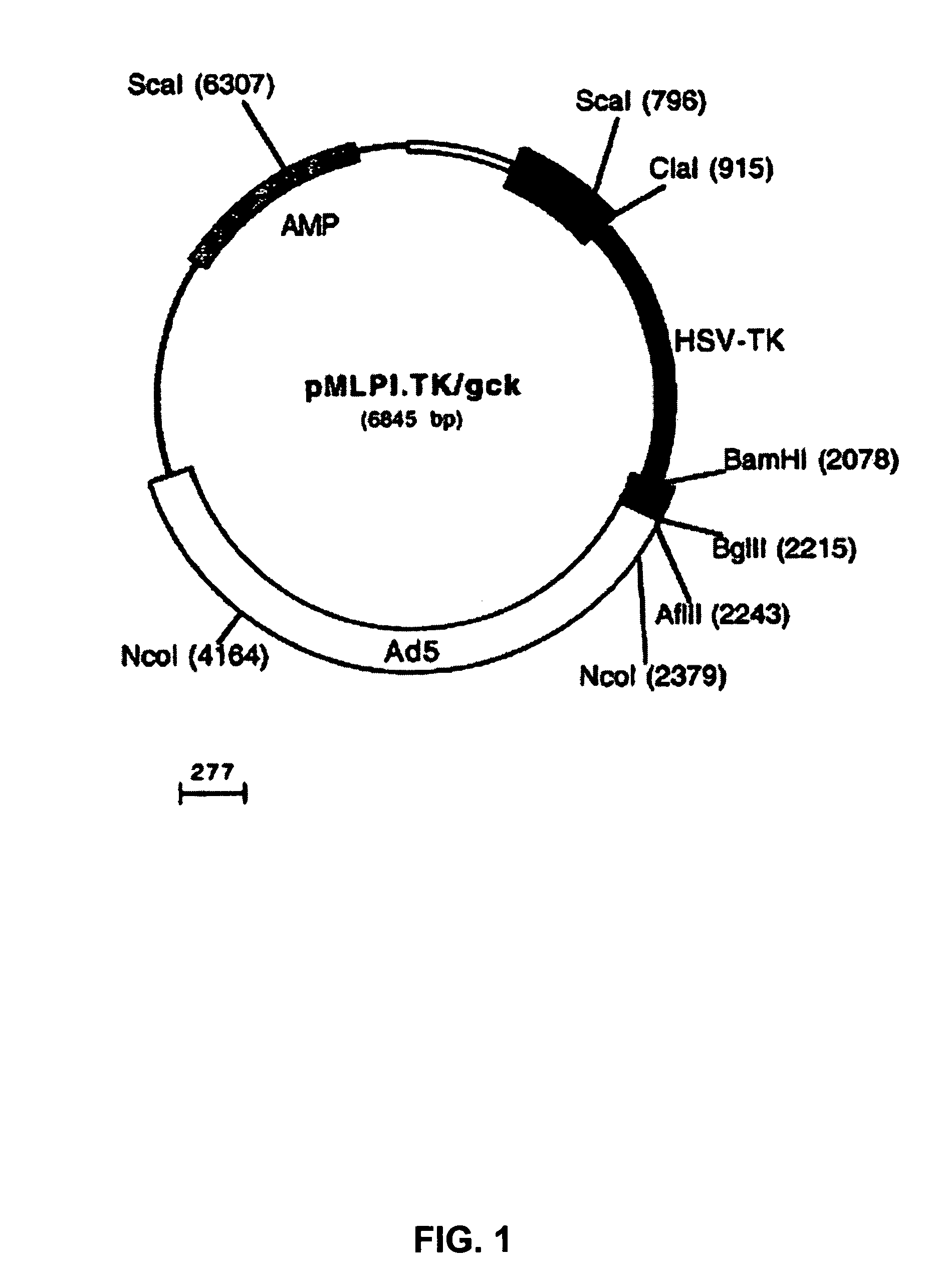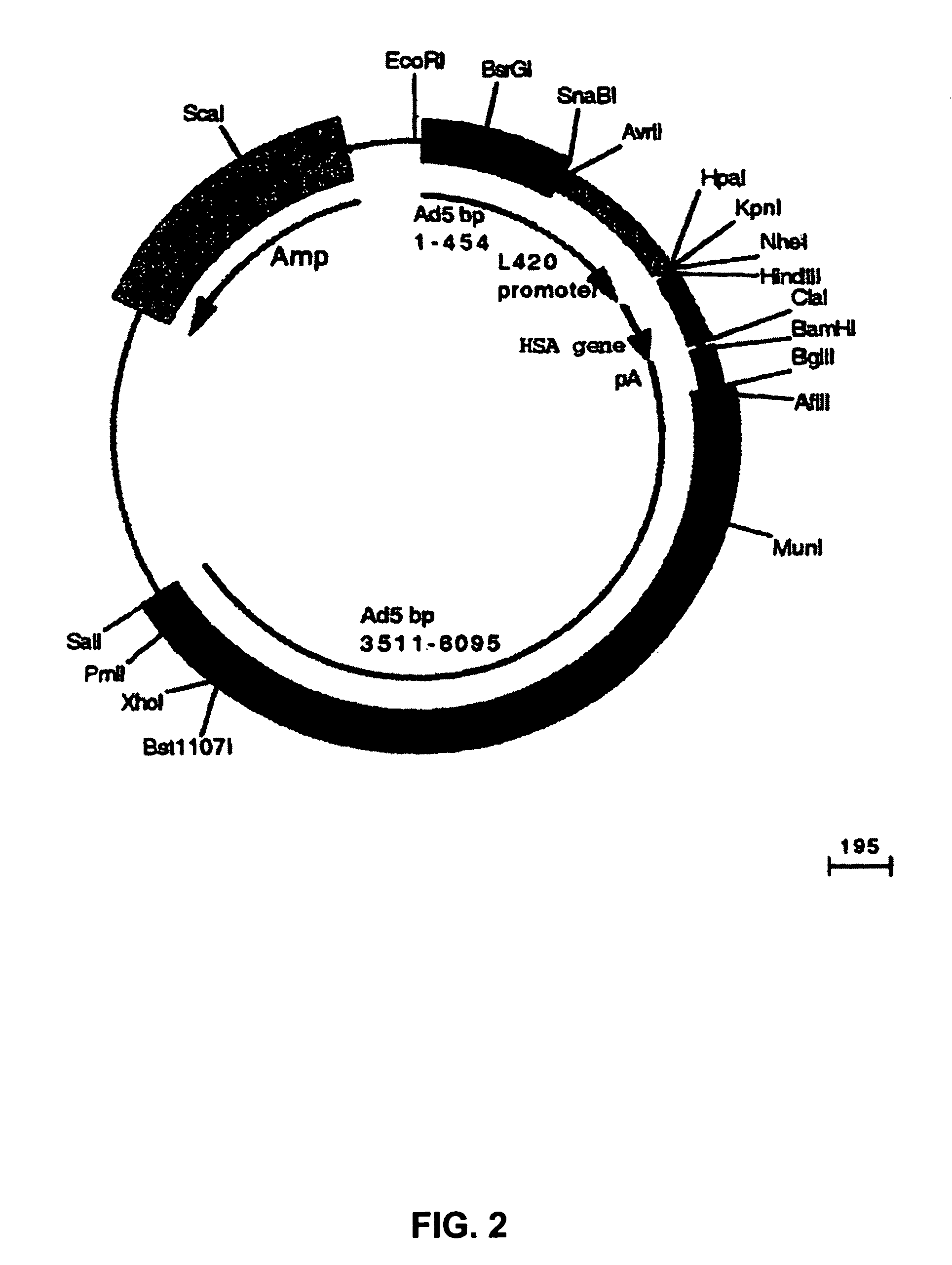Chimeric adenoviruses
a technology of chimeric adenovirus and chimeric adenovirus, which is applied in the field of molecular genetics and medicine to achieve the effect of reducing the effective amount of virus administered
- Summary
- Abstract
- Description
- Claims
- Application Information
AI Technical Summary
Benefits of technology
Problems solved by technology
Method used
Image
Examples
example 1
Generation of Ad5 Genomic Plasmid Clones
[0050]The complete genome of Ad5 has been cloned into various plasmids or cosmids to allow easy modification of parts of the Ad5 genome, while still retaining the capability to produce recombinant virus. For this purpose the following plasmids were generated:
1. pBr / Ad.Bam-rITR (ECACC Deposit P97082122)
[0051]In order to facilitate blunt end cloning of the ITR sequences, wild-type human adenovirus type 5 (Ad5) DNA was treated with Klenow enzyme in the presence of excess dNTPs. After inactivation of the Klenow enzyme and purification by phenol / chloroform extraction followed by ethanol precipitation, the DNA was digested with BamHI. This DNA preparation was used without further purification in a ligation reaction with pBr322 derived vector DNA prepared as follows: pBr322 DNA was digested with EcoRV and BamHI, dephosphorylated by treatment with TSAP enzyme (Life Technologies) and purified on LMP agarose gel (SeaPlaque GTG). After transformation int...
example 2
Generation of Ad5 Based Viruses With Chimaeric Fiber Proteins
[0078]The method described infra to generate recombinant adenoviruses by co-transfection of two, or more separate cloned adenoviral sequences. These cloned adenoviral sequences were subsequently used to remove specific Ad5 sequences in order to generate template clones which allow for the easy introduction of DNA sequences derived from other adenovirus serotypes. As an example of these template clones, the construction of plasmids enabling swapping of DNA encoding for fiber protein is given below.
Generation of Adenovirus Template Clones Lacking DNA Encoding Fiber
[0079]The fiber coding sequence of Ad5 is located between nucleotides 31042 and 32787. To remove the Ad5 DNA encoding fiber we started with construct pBr / Ad.Bam-rITR. First, a NdeI site was removed from this construct. For this purpose, pBr322 plasmid DNA was digested with NdeI after which protruding ends were filled using Klenow enzyme. This pBr322 plasmid was the...
example 3
Production, Purification, and Titration of Chimeric Adenoviruses
[0090]Of the supernatant obtained from transfected PER.C6 cells, typically 10 ml was used to inoculate a 1 liter fermentor which contained 1- 1.5×106 cells / ml PER.C6 that were specifically adapted to grow in suspension. Three days after inoculation, the cells were harvested and pelleted by centrifuging for 10 min at 1750 rpm at room temperature. The chimeric adenoviruses present in the pelleted cells were subsequently extracted and purified using the following downstream processing protocol. The pellet was dissolved in 50 ml 10 mm NaPO4− and frozen at −20° C. After thawing at 37° C., 5.6 ml deoxycholate (5% w / v) was added afterwhich the solution was homogenated. The solution was subsequently incubated for 15 minutes at 37° C. to crack the cells. After homogenizing the solution, 1875 μl (1M) MgCl2− was added and 5 ml 100% glycerol. After the addition of 375 μl DNase (10 mg / ml) the solution was incubated for 30 minutes a...
PUM
| Property | Measurement | Unit |
|---|---|---|
| temperature | aaaaa | aaaaa |
| total volume | aaaaa | aaaaa |
| temperature | aaaaa | aaaaa |
Abstract
Description
Claims
Application Information
 Login to View More
Login to View More - R&D
- Intellectual Property
- Life Sciences
- Materials
- Tech Scout
- Unparalleled Data Quality
- Higher Quality Content
- 60% Fewer Hallucinations
Browse by: Latest US Patents, China's latest patents, Technical Efficacy Thesaurus, Application Domain, Technology Topic, Popular Technical Reports.
© 2025 PatSnap. All rights reserved.Legal|Privacy policy|Modern Slavery Act Transparency Statement|Sitemap|About US| Contact US: help@patsnap.com



